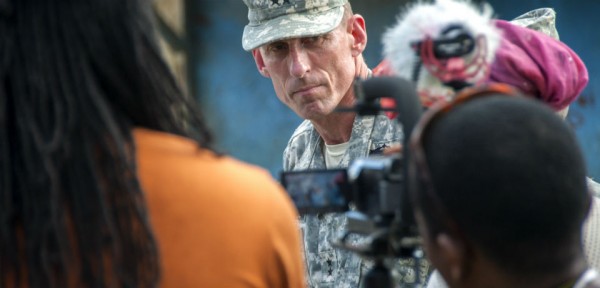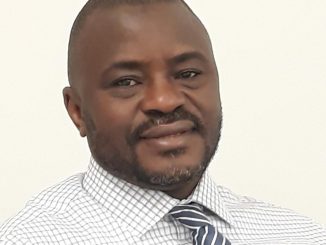
Maj. Gen. Gary Volesky’s 2,500 soldiers have spent months battling a rampant killer in Liberia. Is the fight over, or has the front line shifted?
- BY BRIAN CASTNERBrian Castner is the author of The Long Walk and is a former U.S. Air Force explosive ordnance disposal officer who served two tours in Iraq. He is also a contributor to Wired, the New York Times, Vice, and National Public Radio.






This story has been corrected.
When Maj. Gen. Gary Volesky arrived in Liberia in late October to assume command of the U.S. military effort to help beat back the Ebola epidemic there, he was handed a to-do list by the U.S. Agency for International Development (USAID) and the Liberian government: build 17 temporary treatment facilities across the country, train a mix of international and local Liberian health-care workers to staff them, and use the Pentagon’s high-end medical equipment to test patients’ blood for the deadly virus. Nearly every item is now checked off, leaving three options: go home, stay and wait in case the outbreak worsens, or move to start on a similar list in Sierra Leone and Guinea, where the number of Ebola cases has eclipsed that of Liberia.
Early last week, Volesky, 53, flew in a Black Hawk helicopter from his main headquarters at the Barclay Training Center in Monrovia, the capital, to the small town of Bopolu in northern Liberia to get a progress report on the construction of one of the Army’s Ebola treatment facilities, a small cluster of tents skinned in white tarp that bears the USAID logo. Washington is building fewer of the facilities — 15 rather than 17 — and each one will hold 50 beds instead of 100. That’s because the response to the Ebola outbreak has shifted from a broad attempt to contain an out-of-control crisis to a more focused strategy of tamping out flare-ups. There never were many Ebola cases in Bopolu, but the new treatment facility there is a vital part of the ring of outposts that are being built throughout northern Liberia to guard Monrovia and the cities along the coast against migrants from Sierra Leone and Guinea who may be carrying the virus with them.
The facility had an official ribbon-cutting on Jan. 3, but two days later all of the work was still not complete. The two wards and chain-link fencing were up. Out back there was a decontamination station for ambulances, a new feature that had been previously overlooked during the construction of other facilities. Aspen Healthcare, USAID’s partner providing the actual medical care, was on-site, with local workers taking a break in the shade. The treatment unit was missing only one thing: reliable water.
When giving the tour, the local on-site construction manager for Fluor, the American contractor doing the work, saved the water problem for last. After 20 minutes of good news, Volesky saw the bad. On its first try, Fluor had drilled down 150 feet and had come up dry. So the crews moved the rig to a new spot and were trying again. Until the well was in place, the managers of the treatment center would have to truck in water, hardly a sustainable solution. “I can go home if I hit water!” the construction manager said. Volesky never broke his smile, but he has a way of staring into you that bores holes. He clearly expected the work to be done soon.
Volesky, a native of Spokane, Washington, is well over 6 feet tall, with a prominent nose and long gait. As if conscious of his height, he often hunches over to meet the stature of the person with whom he is talking. Among his soldiers, he talks football. On the job, he is soft-spoken and gracious but all business. His questions in Bopolu were nearly as quick as his stride, and it was clear within a minute or two that he has become an expert in the minutiae of Ebola treatment facility construction, a skill he did not have a few months ago. In many ways, this collection of tents and patient beds in Bopolu looks like every other treatment unit in Liberia, but during the tour Volesky asked different kinds of questions than he would have earlier in his deployment. For example, concerning the units’ eventual dismantlement: “How do you return the land safely?” Even as the treatment units are still being built, planning is underway for their shutdown; acres of gravel seeped for months in Ebola-tainted fluids and chlorine is no small environmental problem.
“We are fighting an enemy, and the enemy is Ebola,” Volesky told me later in his office, a narrow room with an American flag and an enormous 101st Airborne Screaming Eagle logo on the wall.
To state the obvious, though, this enemy looks nothing like others he has fought previously in his career.
To state the obvious, though, this enemy looks nothing like others he has fought previously in his career. Like nearly every other senior U.S. Army officer, Volesky has been shaped by war in the Middle East. He has completed four tours to Iraq (including during the 1991 Gulf War) and one to Afghanistan, and he was awarded a Silver Star as a young battalion commander for leading a rescue mission in Sadr City in 2004.When Volesky took over the 101st Airborne Division in June 2014, his headquarters was slated to go to Afghanistan at the end of the year. Instead, the Ebola epidemic in West Africa this summer prompted President Barack Obama to give Volesky and his staff a new mission: deploy to Liberia to help combat the virus, which was killing thousands and overwhelming the health systems of impoverished countries throughout the region. “Well, that’s interesting,” Volesky remembers thinking when he got news of the Liberia deployment. The deployment order came down in September; on Oct. 25 he took command of the mission in Monrovia.
In a recent sit-down interview with Foreign Policy, Volesky reflected on the accomplishments of his 2,500-person task force and his immediate plans for the future. For a significant portion of his unit, those plans involve getting on a U.S.-bound plane.
“We want to make sure every serviceman and woman we brought here has a task, so we just sent 450 people home,” he said.
He said that his residual force can still do every one of his Ebola-related missions if required and that 20 percent of his manpower got on a plane at the beginning of this year. Those men and women are now settled in for 21 days of monitored quarantine at Joint Base Lewis-McChord in Washington state and at Fort Hood in Texas even though they did not treat Ebola patients or even step inside a functional treatment facility. There was a simple reason for that: Volesky had issued an order explicitly banning his soldiers from doing so.
From the start, Volesky was mindful of ensuring that his troops would have defined tasks that they could do and then turn over to the Liberian government. The last thing he wanted, the major general said, was to build a treatment center that the Liberians would be incapable of operating on their own.
“I am a product of my past experience,” Volesky said. “I remember in Iraq building a school and having this great ribbon-cutting ceremony, and going to that same school two months later and the only people in there are squatters.”
In Liberia, he added, “everything they ask us to do, we say, ‘What is your plan to take it over?’”
The U.S. military role is steadily diminishing as American troops inch toward the door. The Army has finished training 1,200 health-care workers. Under the direction of USAID and at the behest of the Liberian government, NGOs like Partners in Health and International Medical Corps are running the Ebola treatment facilities. Later this week, the Liberian Ministry of Health will present a plan to take over blood testing from the Army. The U.S. military had been using its helicopters to help transport supplies, but even that is proving increasingly unnecessary, as the World Food Program has stepped in. When the Centers for Disease Control and Prevention requested that the Army fly blood samples, Volesky demurred, saying that plan was unsustainable, and the military never used its helicopters to carry any of the potentially Ebola-ridden blood.* Instead, motorcycle couriers deliver most blood samples for Ebola testing, with United Nations helicopters picking up the slack. In other words, it may be time to go home.
But while Volesky is shifting the work to other organizations, planning continues for a possible redeployment to Sierra Leone and Guinea, where the Ebola crisis is far less contained. More than 4,800 people have died in those two countries; Guinea is still seeing a stubborn drumbeat of cases, and Sierra Leone’s death toll is on pace to eclipse Liberia’s. Volesky expects a decision this week from Gen. David Rodriguez, his boss at the headquarters of the military’s Africa Command, on whether his mission will remain in Liberia but shrink further or shift to those other countries completely.
Is the fight won? “In March, everyone declared victory, and then we saw what happened in August and September,” he said, referring to the complacency that developed prior to the disease’s explosion later. So though he is cautiously optimistic that the disease will be brought under control soon, his criterion for determining mission success is not whether Ebola is gone, but whether Liberia has the capacity to fight Ebola on its own.
Back in Bopolu, Fluor workers solved the water problem and opened the treatment facility just a few days after the general’s visit. One more item checked off a rapidly shrinking list. For Volesky and his soldiers, the next item may well involve pulling up stakes, declaring victory, and heading back to the United States.
This story was reported with a grant from the Pulitzer Center on Crisis Reporting.
*Correction, Jan. 15, 2015: The original version of this article incorrectly stated that the U.S. Army had used its helicopters to fly blood samples to labs where they could be tested for Ebola. In reality, the Centers for Disease Control and Prevention had requested such assistance, but the military never carried out such a flight. (Return to reading.)
U.S. Army photo by Sgt. 1st Class Nathan Hoskins, Joint Forces Command-United
FP MAGAZINE



